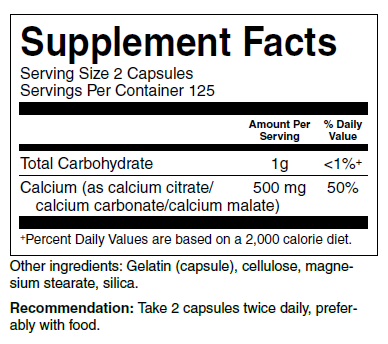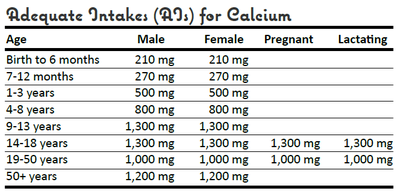Nourish Your Bones and Joints: Size up the Supplement (FN1491, Reviewed Aug. 2019)
Availability: Web only
Size Up the Supplement
Counting tips:
- Supplements have different serving sizes and intake recommendations.
- To determine how many milligrams (mg) of a nutrient are in each capsule, divide the milligrams of that nutrient by the number of capsules in each serving size.
- Remember, you probably are getting some vitamins and minerals from your diet. Be sure to include both supplements and dietary intake when considering if you are getting the right amount of a nutrient.
Note: Adequate intake is the amount that is recommended for the average person to maintain good health.
__________mg/capsule
How many milligrams of calcium are in each capsule of this supplement?
_________capsules/day
How many capsules would you have to take each day to meet the calcium requirement for your age group?


What type of calcium is best?
Many different forms of calcium are available in pill form. Calcium carbonate, calcium citrate, calcium malate, lactate, glucarate, microcrystalline hydroxyapatite and coral calcium are just some examples. Calcium carbonate has been studied the most substantially and usually rates high in absorption. However, some tablets of calcium carbonate are not formulated correctly and do not dissolve adequately. Calcium carbonate also can cause gastric discomforts such as bloating and abdominal pain for some individuals. Calcium citrate usually is absorbed as well as calcium carbonate but without the issues of gastric discomfort. Other forms of calcium have not been studied as extensively.
No matter what type of calcium you decide to take, be sure to check the milligram amount of calcium in each pill and consider your dietary intake to determine how many pills to take each day. Most experts suggest taking calcium with meals and only take 500 mg at one time. If you take a calcium supplement, be sure your supplement also provides vitamin D or you get your vitamin D from a separate supplement.

Size Up the Nutrition Facts Label:
How Much Calcium Is In a Serving of Food?Calculating tips:
Example
- Percent Daily Value (%DV) stands for the percentage of the recommended amount of the nutrient in a serving of a particular food. Daily values are recommendations for adults based on a 2,000-calorie diet. On a Nutrition Facts label, %DV serves as an average recommendation to give consumers a good idea of the nutrient value of a food.
- On any food label, adding “0” to the end of the number in the “%DV” column for calcium equals the number of milligrams of calcium in one serving of the food item. This shortcut only applies to calcium, not other nutrients.
The nutrition label shows that one serving of cereal has 25% DV of calcium. Adding a zero to 25 equals 250. This means a serving of cereal has 250 milligrams of calcium.Note: Different age groups have slightly different recommendations for nutrient intake. Follow your doctor or dietitian’s recommendation based on your individual needs.
How much is one serving of this cereal?_________ cup/servingHow many milligrams of calcium does one serving provide (without milk)?_________ mg/servingWhat percentage of the DV for magnesium is in each serving (without milk)?___________%What percentage of the DV for vitamin D is in each serving (without milk)?___________%Answers: ¾ cup/serving, 20 mg calcium/serving, 6% DV for magnesium/serving,
10% DV for vitamin D/serving

